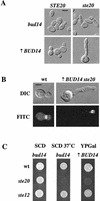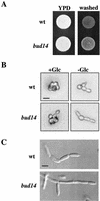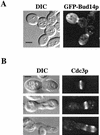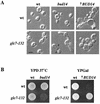The Glc7p-interacting protein Bud14p attenuates polarized growth, pheromone response, and filamentous growth in Saccharomyces cerevisiae
- PMID: 12477789
- PMCID: PMC138766
- DOI: 10.1128/EC.1.6.884-894.2002
The Glc7p-interacting protein Bud14p attenuates polarized growth, pheromone response, and filamentous growth in Saccharomyces cerevisiae
Abstract
A genetic selection in Saccharomyces cerevisiae for mutants that stimulate the mating pathway uncovered a mutant that had a hyperactive pheromone response pathway and also had hyperpolarized growth. Cloning and segregation analysis demonstrated that BUD14 was the affected gene. Disruption of BUD14 in wild-type cells caused mild stimulation of pheromone response pathway reporters, an increase in sensitivity to mating factor, and a hyperelongated shmoo morphology. The bud14 mutant also had hyperfilamentous growth. Consistent with a role in the control of cell polarity, a Bud14p-green fluorescent protein fusion was localized to sites of polarized growth in the cell. Bud14p shared morphogenetic functions with the Ste20p and Bni1p proteins as well as with the type 1 phosphatase Glc7p. The genetic interactions between BUD14 and GLC7 suggested a role for Glc7p in filamentous growth, and Glc7p was found to have a positive function in filamentous growth in yeast.
Figures








Similar articles
-
The Bud14p-Glc7p complex functions as a cortical regulator of dynein in budding yeast.EMBO J. 2005 Sep 7;24(17):3000-11. doi: 10.1038/sj.emboj.7600783. Epub 2005 Aug 18. EMBO J. 2005. PMID: 16107882 Free PMC article.
-
Dynamic localization of protein phosphatase type 1 in the mitotic cell cycle of Saccharomyces cerevisiae.J Cell Biol. 2000 Apr 3;149(1):125-40. doi: 10.1083/jcb.149.1.125. J Cell Biol. 2000. PMID: 10747092 Free PMC article.
-
Functional analysis of the yeast Glc7-binding protein Reg1 identifies a protein phosphatase type 1-binding motif as essential for repression of ADH2 expression.Mol Cell Biol. 1999 Sep;19(9):6029-40. doi: 10.1128/MCB.19.9.6029. Mol Cell Biol. 1999. PMID: 10454550 Free PMC article.
-
Regulation of yeast glycogen metabolism and sporulation by Glc7p protein phosphatase.Genetics. 1998 May;149(1):57-72. doi: 10.1093/genetics/149.1.57. Genetics. 1998. PMID: 9584086 Free PMC article.
-
Sds22p is a subunit of a stable isolatable form of protein phosphatase 1 (Glc7p) from Saccharomyces cerevisiae.Arch Biochem Biophys. 2000 Apr 15;376(2):288-98. doi: 10.1006/abbi.2000.1715. Arch Biochem Biophys. 2000. PMID: 10775415
Cited by
-
Glc7/protein phosphatase 1 regulatory subunits can oppose the Ipl1/aurora protein kinase by redistributing Glc7.Mol Cell Biol. 2006 Apr;26(7):2648-60. doi: 10.1128/MCB.26.7.2648-2660.2006. Mol Cell Biol. 2006. PMID: 16537909 Free PMC article.
-
The Bud14p-Glc7p complex functions as a cortical regulator of dynein in budding yeast.EMBO J. 2005 Sep 7;24(17):3000-11. doi: 10.1038/sj.emboj.7600783. Epub 2005 Aug 18. EMBO J. 2005. PMID: 16107882 Free PMC article.
-
Functional organization of the S. cerevisiae phosphorylation network.Cell. 2009 Mar 6;136(5):952-63. doi: 10.1016/j.cell.2008.12.039. Cell. 2009. PMID: 19269370 Free PMC article.
-
Comparative polygenic analysis of maximal ethanol accumulation capacity and tolerance to high ethanol levels of cell proliferation in yeast.PLoS Genet. 2013 Jun;9(6):e1003548. doi: 10.1371/journal.pgen.1003548. Epub 2013 Jun 6. PLoS Genet. 2013. PMID: 23754966 Free PMC article.
-
Diverse protein kinase interactions identified by protein microarrays reveal novel connections between cellular processes.Genes Dev. 2011 Apr 1;25(7):767-78. doi: 10.1101/gad.1998811. Genes Dev. 2011. PMID: 21460040 Free PMC article.
References
-
- Andrews, P. D., and M. J. Stark. 2000. Type 1 protein phosphatase is required for maintenance of cell wall integrity, morphogenesis and cell cycle progression in Saccharomyces cerevisiae. J. Cell Sci. 113:507-520. - PubMed
-
- Bailis, J. M., and G. S. Roeder. 2000. Pachytene exit controlled by reversal of Mek1-dependent phosphorylation. Cell 101:211-221. - PubMed
Publication types
MeSH terms
Substances
Grants and funding
LinkOut - more resources
Full Text Sources
Molecular Biology Databases

